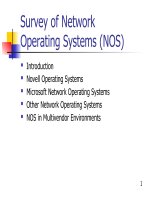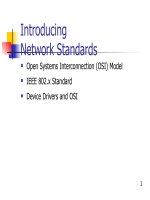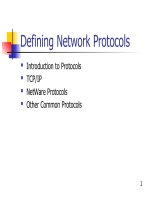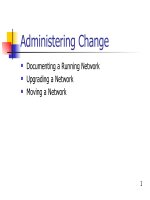Lecture Networking essentials plus (3 e) Chapter 5 Introducing network standards
Bạn đang xem bản rút gọn của tài liệu. Xem và tải ngay bản đầy đủ của tài liệu tại đây (527.52 KB, 27 trang )
Introducing
Network Standards
Open Systems Interconnection (OSI) Model
IEEE 802.x Standard
Device Drivers and OSI
1
Open Systems Interconnection
(OSI) Model
Network Communications
OSI Model
Windows NT and the OSI Model
2
Network Communications
Sending Computer Must:
Recognize data
Divide it into manageable chunks
Add information to determine its location and
identify the receiver
Add timing and error-checking information
Put data on the network and send it
3
Seven-Layer OSI Model
4
OSI Layer Relationships
5
Application Layer (7)
Topmost layer
Represents services that directly support user
applications
Window to network services
Handles network access, flow control, and error
recovery
6
Presentation Layer (6)
Network translator
On sending end, determines formatting used to
exchange data among computers and adds
formatting so data can be understood by network
On receiving end, translates data from application
format to a common intermediate format
Manages data compression, translation, encryption
I/O redirectors work to redirect resources to a server
7
Session Layer (5)
Allows two applications on different computers to
open, use, and close connections
Performs name recognition and provides security
Provides synchronization by placing checkpoints in
the data stream
Implements dialog control between communication
processes
8
Transport Layer (4)
Sending end: repackages message, divides long
messages to ship properly over determined route and
arrive error-free
Receiving end: unpacks message, reassembles it,
and acknowledges receipt
Provides flow control, error handling, and solves
transmission problems
9
Network Layer (3)
Addresses the package using network address
scheme
Determines the best route on the network based on
network conditions, priority of service
Performs packet switching, routing, traffic
management, and controls congestion of data
10
Data-Link Layer (2)
Sending end: sends data frames from network layer
to physical layer
Receiving end: packages raw bits from physical layer
into data frames
Parts of data frame: Destination ID, Sender ID,
Control Data
Acknowledges data frames, error checking, and
verification
11
Simple Data Frame
12
Physical Layer (1)
Bottommost Layer
Hardware-oriented, establishes and maintains
physical link between communication computers
Defines how the cable is attached to the NIC
Packet sent as an unstructured raw bit stream over
physical medium
Referred to as the “hardware layer”
13
OSI Model Layer Mnemonics
OSI Layer
Down
Up
Application
Presentation
Session
Transport
Network
Data-Link
Physical
All
People
Seem
To
Need
Data
Processing
Away
Pizza
Sausage
Throw
Not
Do
Please
14
Packet Assembly and
Disassembly Process
15
Windows NT and OSI
16
Software and Protocols
17
Windows NT Architecture
with Boundary Interfaces
18
The IEEE 802.x Standard
The 802 Project Model
19
802 Specifications
Set Standards for:
Network Interface Cards (NICs)
Wide area network (WAN) components
Components used to create twisted-pair and coaxial
cable networks
20
802 Specification Categories
802.1
802.2
802.3
Internetworking
Logical Link Control (LLC)
MAC layer, Carrier Sense Multiple Access with Collision Detection
(CSMA/CD) LAN (Ethernet)
802.4
MAC layer, Token Bus LAN
802.5
MAC layer, Token Ring LAN
802.6
802.7
802.8
802.9
802.10
802.11
802.12
802.13
802.14
802.15
802.16
Metropolitan area Network (MAN)
Broadband Technical Advisory Group
Fiber-Optic Technical Advisory Group
Integrated Voice/Data Networks
Network Security
Wireless Network
Demand Priority Access LAN, 100BaseVG-AnyLAN
Unused
Cable modem standards
Wireless personal area networks (WPAN)
Broadband wireless standards
21
Project 802 LLC and
MAC Sublayers
22
Project 802 LLC and
MAC Standards
23
Device Drivers and OSI
Role of Drivers
Network Environment
Network Driver Interface Specifications (NDIS)
Open Data-Link Interface (ODI)
Bridging NDIS and ODI
24
Role of Drivers
Drivers for nearly every type of device including:
Input devices, such as mouse and keyboard devices
SCSI and IDE disk controllers
Hard and floppy-disk drives
Multimedia devices such as microphones, cameras, and recorders
Network Interface Cards (NICs)
Printers, plotters, tape drives, and so forth
25









